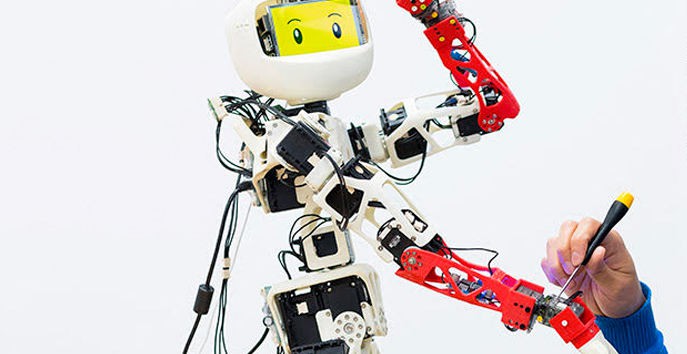Easy start-up with the Poppy Humanoid robot!
Assembling the robot
Start by checking that you received all parts (list for Poppy Humanoid and Poppy Torso). The boxes with only one Dynamixel servomotor contain a 20cm cable and a horn (HN07-N101 for MX-28 and HN05-N102 for MX-64), so what you received should match with the official bill of materials.
Get the following tools: Allen wrenches of sizes 1.5, 2 and 2.5 mm, Phillip’s screwdriver (long and thin), mini flat screwdriver (for electronical devices), presser (and optionnally tweezers).
Here we go! Read our assembly videos. You can also directly flash the Odroid board’s eMMC module with this system image (for Poppy Humanoid) or this one (for Poppy Torso).
Book at least two days for the assembly. You will also need a computer to address the servomotors, using the software Herborist or Dynamixel wizard.
Robot Programming
The software quickstart guide gives you an overview of all the ways to program a Poppy Humanoid robot.
You can also develop directly on the robot with ipython notebooks. Open a terminal inside the robot (see ‘setup the Odroid board’ in the assembly guide to know how to use ssh) and type:
ipython notebook –ip 0.0.0.0 –no-mathjax –no-browser
It’s also possible to program the root with Snap! (graphical programming software), with Pypot (Python library allowing to control the Dynamixel servomotors). You can also save and replay moves.
You can also use the V-rep simulateur.
Build a Poppy creature
Poppy‘s world is not limited to Poppy Humanoid, Poppy Torso and Ergo robots! Any robot built in the same open-source spirit and using the Pypot library can be considered as a Poppy creature.
If you simply want to re-print a part or modify an existing robot, the files are available here.
If you want to build a new creature from scratch, read these advises.
Participate in the community
Community is an important part of the Poppy project. Don’t hesitate to show your projects or to ask help and advises on the forum, get Pypot’s source code and improve it or create your own Poppy creature. We are waiting for you!
Flash asystem image on the eMMC module of the Odroid U3 board
The eMMC module contains the operating system and all your data. It is read by the Odroid U3 board that offers the interfaces (USB, ethernet..) to use the data.
Flashing a system image on the eMMC module allows you to initially setup the operating system (with all Poppy libraries already installed if you use the system images created by our team) or to come backto a known state after a corruption.
Warning, this manipulation will erase for good all data on the module, so be sure to save elsewhere (on a server or a USB stick) everything you wish to reuse.
Using Linux or Mac
- Download the system image of your choice (see section assembling the robot for the images for Poppy Humanoid and Poppy Torso)
- Uncompress the image: unxz image-name.img.xz You get a .img file.
- List all available disks: df -h
- Plug the eMMC module on its adaptator and connect it to your computer. Then run the previous command again. The new disk(s) (for example /dev/sdc1 and /dev/sdc2) correspond to the eMMC module. Write the name down (if you have several disk names, remove the number at the end to keep only one disk name, for example /dev/sdc)
- Unmount each of these disks:umount <disk-name-with-the-number>
- Warning: the following command may erase your data if uncorrectly executed ! sudo dd if=<image-path> of=<disk-name>
if (input file) contains the name of the uncompressed image (the .img file) and of (output file) is the name of the disks without the number at the end that you wrote down on a previous step. Flashing the module may more than 40 minutes. - Plug the eMMC module on th eOdroid U3 board, power the board and connect it to the network using an ethernet cable. It should appear on your network with the name poppy.local (if you use one of our Poppy images). You can now update the Poppy libraries and start working with your Poppy Humanoid or Poppy Torso robot.
Using Windows
- Download the system image of your choice (see section assembling the robot for the images for Poppy Humanoid and Poppy Torso)
- Uncompress the image using the software you prefer (for example 7zip). You get a .img file.
- Download and install the Win32 Diskimager software.
- Plug the eMMC module on its adaptator and connect it to your computer.
- Run disk imager as administrator. Select the system image (the .img file) and the disk you want to flash. Warning, a wrong choice may erase your data! Wait for the flash to end.
- Plug the eMMC module on th eOdroid U3 board, power the board and connect it to the network using an ethernet cable. It should appear on your network with the name poppy.local (if you use one of our Poppy images). You can now update the Poppy libraries and start working with your Poppy Humanoid or Poppy Torso robot.

